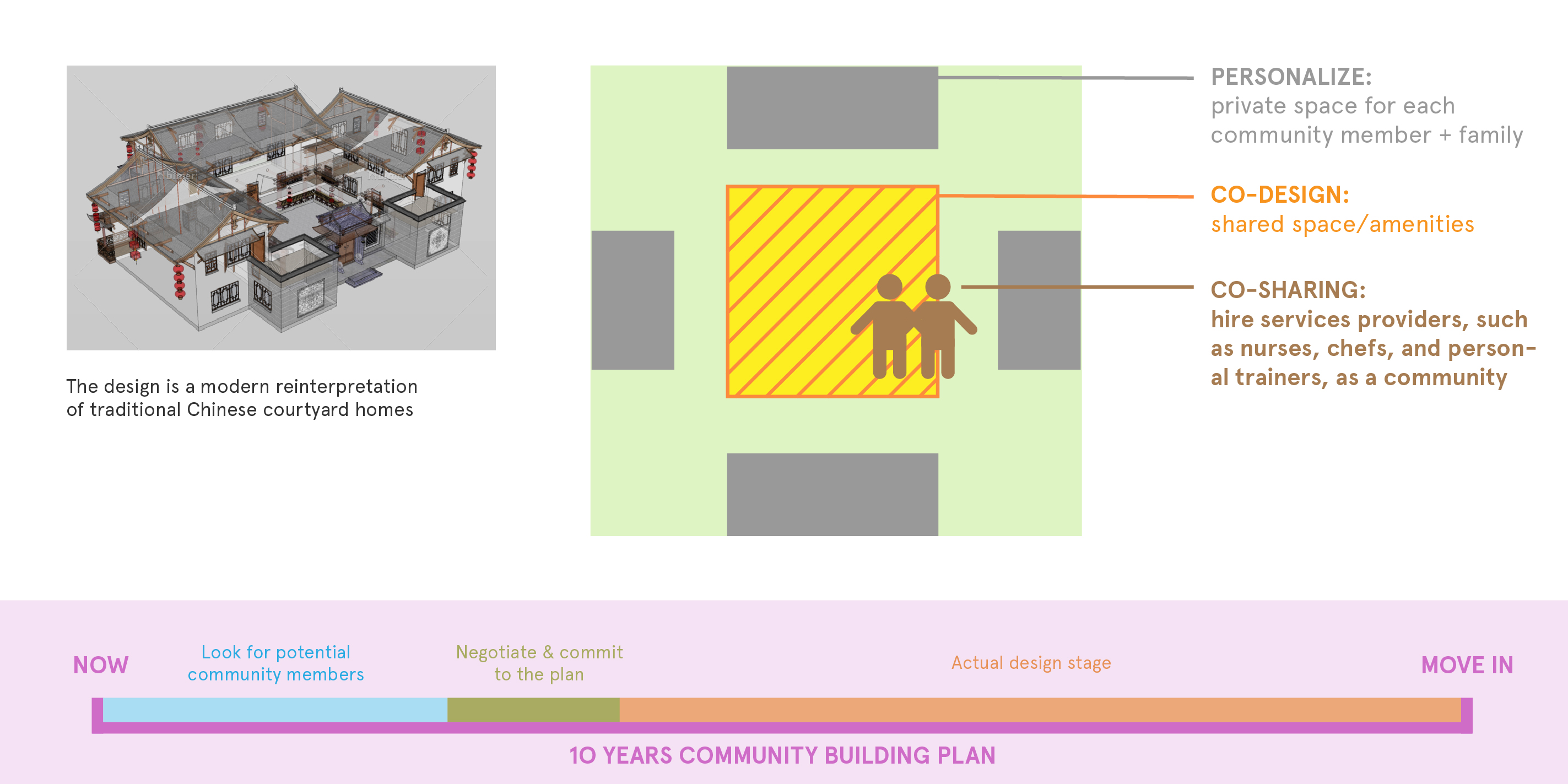“Huddling Retirement”—The Interdependent Elder-Care Trend in China
Posted on December 17, 2018The Phenomenon: Why Huddling?
Talking about death is never easy, and asking my parents how they would like to spend rest of their lives and how I can fully support my loved ones to live and die in the way they want is even harder. Being born during the one-child policy and living apart from home since high school, there is always a sense of guilt when I attempt to cope with the uncertainty of my own future and realize I might not be at my parents’ side as they approach the end of life. Fortunately, Design for Living and Dying studio became this wonderful opportunity where I could open up this difficult conversation with them under the name of conducting research. Surprisingly, the conversation was not as uncomfortable and emotional as I expected. Instead, my parents presented me the concept that they have been craving for a long time, which is “huddling retirement”.
The concept of “huddling retirement” refers to the situation where single-child parents who live separately from their children gather together to live together and independently look after each other.[1] This growing phenomenon is closely tied to the cultural context and policy in China: due to the inadequacies in state-provided elder care facilities and cultural tradition, the traditional elder-care model heavily relies on adult children to take on the primary caregiver role. Such a model has became unsustainable as China started one-child policy in 1979 and the shared responsibility of elder care shifts to the one and only child in the family.[2] Under the impact of globalization and geographic mobility, an increasing number of young people moved to other cities and countries for educational and employment opportunities. This is when a lot of parents realize they cannot simply rely on their only children nor the undermanned state-provided nursing home to be taken care of. “When you cannot rely on anyone,” my father said, “you have to rely on yourself.”

An existing “huddling community” in Wuhan, Hubei province
As my parents envisioned their future huddling community, I used my design and graphic skill to visual, actualize, and further develop their ideas and the mechanic aspects. They both hope to connect with 3 to 4 families who are in the similar split family situation to co-build the community together. The most ideal scenario would be all families to purchase relatively affordable land and build everything together from scratch. Each family will have their own personalized individual private space, whereas the communal space will be co-designed by all community members according to their needs. Outside services, such as healthcare providers, will be hired and shared by all members to reduce the cost.

Moving Forward: What Is A Designer’s Role in Paradigm Shifts?
I was extremely amazed by the concept of huddling retirement and people’s ability and creativity to thrive under undesirable circumstances. In some ways, I perceive it as a means of challenging and reframing the traditional sense of family in Chinese culture, which is heavily based on the blood relationship. I even started to imagine how the concept of a family would be like in the future: a family that is potentially structured based on shared values and experiences, instead of blood ties. How would this impact the existence and attachment to the biological family? Will biological family even exist in the future? Meanwhile, there is always a sense of sadness as I drafted out the community plan, because I know the idea of huddling retirement is not out of my parents’ (and potentially other parents’) primary interests, it is more of an intervention and a response to a systematic problem that they experience. My parents’ generation grew up with a strong sense of family values, but this ideology is now challenged by cultural policy and shifts, and the inexorable rise of individualism and globalization. Being adaptable to this new approach of elder care certainly requires them to give up some values and expectations they hold on to.
The example of emerging Chinese interdependent elder care models is one of many systematic problems that people experience today. As a designer, I think now is an intriguing time to study design and rethink what design can do. Instead of temporarily fixing problems within flawed systems, I see the possibilities of rethinking and transforming the way we live through design and systematic thinking and approaches. Considering the limited impact of individuals, what role should I take on as a designer in paradigm shifts? My parents are an example of taking the initiatives to adapt the system. I believe people are the ones who know what they really want. Instead of perceiving designers as creators, perhaps, we are also liaisons who design with people transforming their storers, visions, and values into some tangible. As I develop the idea of huddling community with them, I also wonder if this self-initiated act can actually impact the broader system we live in? I don’t have the answer, but I definitely see the opportunities for me as a designer to take the similar idea and adapt it in other countries and cultural contexts, to present people multiple possibilities of coping and living with systematic impact and crises.
Danni
References
Fan Yiying, “Why China’s Elderly ‘Huddle to Stay Warm,”, accessed December 15th, 2018, https://www.sixthtone.com/news/1001858/why-chinas-elderly-huddle-to-stay-warm.